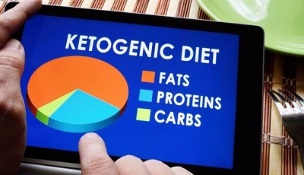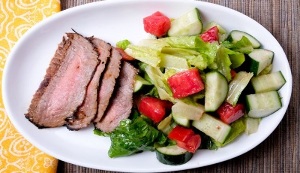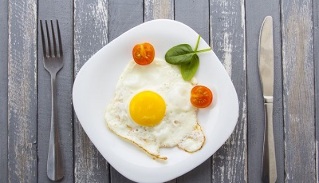
Lack of hunger attacks, a clean mind and rapid weight loss are the benefits of a ketogenic diet. Learn what types of keto diets are right for you and choose the one that works best for you!
Ketogenic diet is no longer a newcomer to the world of nutrition and weight loss, but continues to be the most controversial method around. And also because the proponents believe: in fried chicken legs and juicy cutlets you can not only lose weight, but also never lose weight. Doctors warn that the keto diet is difficult, dangerous, not fully understood and full of many side effects.
Fat diets came to us from the medical world, where they were often used to treat epileptic seizures in children. It is one of the types of low carb nutrition programs. However, the main difference between the ketogenic system and conventional systems is that fats are the main food in the diet.
How it works
The most optimal nutrient ratio (BZHU) in a normal diet is 1: 1: 4, ie the basis of the diet is carbohydrates. They are the main source of energy (calories) and necessary for the nervous system as a source of glucose. However, numerous studies confirm that this is not entirely true. Swedish scientists have shown that after depletion of their glycogen stores, the body goes into another "regime" as a result of the rejection of saccharides, along with an increase in fat and protein. Habit metabolism is rebuilt and glycids are no longer the main source of energy. The liver produces a special form of acetone called ketones (ketone bodies) that move through the bloodstream and affect the oxidation of fatty acids. As a result, our body enters a state of ketosis and extracts energy not from carbohydrate chains, but from fat processing products, first depleting subcutaneous fats, and then using fats from food. The experiments of scientists have confirmed that ketones are a more physiological fuel for the brain, while sugars are a cheap and fast energy, which can lead to degenerative brain diseases in the future.
After extensive research, professional athletes and bodybuilders are interested in this method. Cat food has become popular and has gone from diet to rapid weight loss, strengthening and gaining muscle mass, lack of constant hunger, and ultimately a lifestyle that promises a different life.
However, despite its effectiveness, doctors warn: ketogenic diet is associated with the calculation of nutritional norms, so it is prescribed and monitored by a nutritionist. It is important to start, protect and manage ketosis properly. Creating a menu program yourself means putting your health at great risk!
Basic views
Professional athletes distinguish three main types of ketogenic diets:
Standard (SKD - standard ketogenic diet)

This is a basic linear program with medium and high protein intake, high fat intake and low saccharide intake in the diet. It is characterized by a continuous ketogenic food supply without glycine replenishment cycles. SKD is excellent for people with low activity (sedentary lifestyle, irregular sports).
How is food balance calculated? For example, consider a standard ketogenic diet for a 75-pound person who exercises 2-3 times a week.
- First, let's calculate your daily caloric intake (KRday). For example, it will be 2000 kcal per day.
- The required amount of protein (Bsut) is 2 grams per 1 kg of body weight, ie for our sample Bsut = 2 * 75 = 150 grams / day.
- Daily carbohydrate intake (Usut) is 0, 2-0, 4 grams. Weight per 1 kg, ie 15-30 grams / day (for calculations we will get the norm of 30 grams).
- Let's calculate how many calories from protein and glycides in the daily diet. Each of these foods is known to have 4 calories per gram. Therefore, in our calculation, this value is (150 + 30) * 4 = 720 kcal.
- As you can see, for our example, a person should get 1280 kcal (2000-720) from fat. And since 1 gram of fat is 9 kcal, the daily amount of fat (F / day) = 1280/9 = 142 grams.
As a result of calculations, we found that for this situation, the diet consists of 150 grams of protein, 30 grams of carbohydrates and 142 grams of fat, evenly distributed between meals.
Cyclic (CKD - cyclic ketogenic diet)
An option for experienced bodybuilders who feel good about their bodies and understand the rules of proper nutrition, calories and diet. CKD is suitable for athletes who train daily and report a decrease in training efficiency against the background of basic and targeted systems. The purpose of this method is to determine the correct period between carbohydrate loading days (re-feeding) and to calculate the amount of glycides that allow your body to work at maximum intensity.

Bodybuilders recommend gradually applying refeeds starting at once a week and monitoring your well-being by adjusting the time interval between loads to individual needs. Write down how many carbs you consume per day and how you generally feel.
The basic rule of the loading day: W / day should decrease, and B / day should remain unchanged (or increased). U / day depends on the individual sensitivity to insulin and below 2-3 g per 1 kg, normally 4-5 g per 1 kg, with high sensitivity 6-7 g per 1 kg.
Let's calculate the caloric content of CDC with normal insulin sensitivity.
- B / day = 2 * 75 = 150 grams per day.
- Y / day = 450 to 525 grams / day.
- The daily caloric content of protein and sugars on a carbohydrate load day is (150 + 450) * 4 = 2400 kcal.
- As in the previous calculation, we calculate the remaining calories, divide the number obtained by 9 and get how many grams of fat will be included in the diet on carbohydrate days.
Thus, calculations show that during 6 days of CKD, the menu will be prepared as in CKD, and the caloric content of one day (carbohydrate) is 2500 kcal (150 g of protein, 300 g of carbohydrates and 78 g of fat)
TKD-target ketogenic diet
Suitable for long-term athletes who experience a sharp decline in performance after a long time without glycide and can benefit from low carbohydrate intake. It is characterized by the "injection" of saccharides over a period of time called the "exercise window" (ie before and after exercise), which will increase endurance but not suppress the ketosis process. The goal of targeted ketogenic nutrition is to provide a short-term improvement in performance and endurance. In the absence of training, indicators for SKD are obtained.
For our example, let's calculate Y / day before and after training:

- B / day = 2 * 75 = 150 grams per day.
- The increase in Y / day depends on insulin resistance and is +0. 5 g per 1 kg with low sensitivity, +0, 75 g per 1 kg with normal and +1 g per 1 kg with high sensitivity. It is recommended to divide these extra carbohydrates into two equal parts and eat before and after exercise.
- As in previous calculations, subtract the daily calories of the diet and carbohydrates from the total calories of the diet. The result will be calories related to delta fat.
Attention!This calculation is not a rule, but just an example. The calculation of indicators for the main menu should be based on individual characteristics, and precise adjustment of the target and cyclic ketogenic diets should be based on well-being, performance, endurance, intensity and duration of the training period only through trial and error. If you are unsure of your skills and experience, we recommend that you contact a nutritionist.
Rules
Follow these instructions to get the weight loss results you want:
- Start fasting one day. Only water is allowed.
- The diet should consist of: "proper" fats - 60%, protein - 30%, carbohydrates at least 10% of daily caloric intake.
- Mandatory intake of vitamins and minerals (calcium, vitamin D, folic acid).
- Drink as much as possible.
- To consume food from the allowed list.
Permitted and prohibited products
The following facilitate the onset and maintenance of ketosis:
- high-fat fermented dairy products (including cottage cheese);
- lard, fatty meats, skinned birds;
- sausage (jam, fish, boiled pork);
- fish (preferably oily) and seafood;
- hard cheeses (try to choose cheeses with a minimum amount of carbohydrates);
- avocado;
- oils (butter, unrefined vegetable oils, coconut);
- mushroom;
- fiber-rich vegetables;
- banana;
- nuts, walnut pastes;
- pumpkin seeds;
- leafy salads.
Minimum permission:
- dark, bitter chocolate with maximum cocoa content and minimum sugar;
- raw roots, vegetables, fruits that have not been heat treated;
- tea, coffee.
Prohibited Products:
- carbonated drinks;
- sugar, honey;
- baked goods, bread;
- cereals;
- dried fruits;
- skim milk, kefir, yogurt;
- margarine, spread;
- pasta;
- starchy vegetables.
Menu

When designing a weekly menu for a ketogenic diet, nutritionists recommend not paying attention to the weight of the food, preparing a menu based on volume, and calculating the BJU ratio.
Approximately ketogenic menu for a week, taking into account the recommendations.
Monday
- Breakfast: scrambled eggs from 2 eggs; hard cheese; pig; a cup of coffee.
- Dinner: vegetable salad sprinkled with mayonnaise (leafy "Iceberg" + cucumber + celery); fried chicken with skin; hard cheese.
- Meals: steak; cauliflower cooked with mushrooms; creamy coffee.
Tuesday
- Breakfast: cutlet; hard cheese; a cup of milk american.
- Lunch: golden steak with cream sauce; steamed broccoli; salad salad with cheese and eggs decorated with mayonnaise.
- Food: pork; baked cabbage; vegetable salad; tea.
Wednesday
- Breakfast: 6 egg omelets with grated cheese (can be replaced with a protein cocktail); soy milk - 0, 5 l.
- dinner: smoked breast; fried pumpkin with cheese.
- Meal: red fish with creamy sauce; vegetable salad with mayonnaise; yogurt.
Thursday
- Breakfast: boiled eggs - 4-5 pieces; spoons of any sauce - 2–3 tbsp. spoon; vegetable salad with cheese.
- Dinner: mushrooms cooked with sour cream; spinach salad; Fried fish.
- Meals: meat steak; toast with honey; milk.
Friday
- Breakfast: scrambled eggs (3-4 eggs); protein shakes; hard cheese.
- Lunch: scrambled eggs; fried chicken breast; hard cheese.
- Food: salmon; unroasted almonds; salad.
Saturday
- Breakfast: salmon; grapefruit; salad.
- Lunch: fish; vegetable casserole; a mixture of nuts.
- Lunch: vegetable salad; a few sausages; Cheese.
Market
- Breakfast: eggs in a bag; Pendir; vegetable salad.
- Lunch: turkey; tomato salad with mayonnaise; Cheese.
- Meals: cottage cheese; grapefruit.
Make sure you follow your drinking regimen. Drink at least 1. 5 liters of water during the day.
Contraindications and side effects
Within a few days after starting a ketogenic diet, you may feel weak, lethargic and depressed. This type of nutrition is not natural and is therefore especially dangerous for a growing organism. This food is completely contraindicated for teenagers. The following side effects can occur during a long-term or improper ketogenic diet:
- urolithiasis;
- increase in bad cholesterol levels in the blood;
- peristalsis disorder, functional condition of the gastrointestinal tract (gastroesophageal reflux);
- dehydration (because carbohydrates take up excess water);
- growth retardation (in young people) due to protein deficiency;
- vitamin deficiency;
- mineral deficiency and consequent bone remineralization, osteoporosis;
- inflammation of the pancreas (pancreatitis);
- hormonal imbalance and menstrual cycle deficiency;
- ketoacidosis.
Therefore, the diet is managed by a specialist to prevent the development of pathological diseases and the exacerbation of existing ones. When losing weight, monthly monitoring of the condition, delivery of basic tests (blood, urine) is recommended. Correction or cancellation of the ketogenic diet is carried out by a doctor based on the results of the examination.




























